The Doom Generation Blu-ray Movie
HomeThe Doom Generation Blu-ray Movie 
Strand Releasing | 1995 | 83 min | Not rated | Sep 26, 2023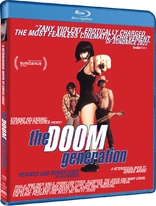
Movie rating
6.5 | / 10 |
Blu-ray rating
| Users | 0.0 | |
| Reviewer | 3.5 | |
| Overall | 3.5 |
Overview
The Doom Generation (1995)
Jordan White and Amy Blue, two troubled teens, pick up an adolescent drifter, Xavier Red. Together, the threesome embark on a sex- and violence-filled journey through an America of psychos and convenience stores.
Starring: Rose McGowan, James Duval, Johnathon Schaech, Dustin Nguyen, Margaret ChoDirector: Gregg Araki
| Surreal | Uncertain |
| Dark humor | Uncertain |
| Teen | Uncertain |
| Crime | Uncertain |
Specifications
Video
Video codec: MPEG-4 AVC
Video resolution: 1080p
Aspect ratio: 1.85:1
Original aspect ratio: 1.85:1
Audio
English: DTS-HD Master Audio 5.1 (48kHz, 24-bit)
3679 kbps
Subtitles
English SDH
Discs
Blu-ray Disc
Single disc (1 BD)
Playback
Region A (locked)
Review
Rating summary
| Movie | 4.0 | |
| Video | 4.0 | |
| Audio | 4.5 | |
| Extras | 2.0 | |
| Overall | 3.5 |
The Doom Generation Blu-ray Movie Review
Reviewed by Dr. Stephen Larson November 6, 2023While not a big studio film, The Doom Generation (1995) is an important work in Gregg Araki's career because its $1 million budget granted him a fuller film crew than any other that he had up to this point. It is also significant creatively because Araki experimented more with the image and employed some subversive editing techniques. The Doom Generation is the middle entry in the indie auteur's "Teenage Apocalypse Trilogy." It was preceded by Totally F***ed Up (1993) and followed by Nowhere (1997).
Jordan White (James Duval) and his girlfriend of three months, 18-year-old Amy Blue (Rose McGowan), leave a nightclub for a drive-in movie theater where they are about to make love for the first time. But they are interrupted by a man climbing on top of Amy's car. Xavier Red (Johnathon Schaech) is a mysterious drifter who's been attacked by skinheads and bolts into Amy's car, asking her to quick drive away. Jordan, who calls Xavier "X," welcomes the stranger but Amy wants him to get out. Nonetheless, she lets X stay and the trio head to a Quickie Mart. When Amy and Jordan attempt to checkout some items, they realize they've left their money in the car. That doesn't sit well with the cashier (Dustin Nguyen), who threatens them at gunpoint with a shotgun. X intercedes the confrontation by "accidentally" killing (as he puts it later) the Quickie Mart clerk. After fleeing the scene, the three drifters approach a drive-through window at a fast-food restaurant where a cashier (Nicky Katt) claims that Amy is an ex-lover of his. Amy is appalled by the claim and cusses him out. Agitated, the cashier also pulls out a shotgun and fires at Amy's careening car.
The angst-ridden teens live off fast food, coffee, cigarettes, and drugs. (Amy is a crystal meth addict.) They hop from one cheap motel to another where Amy has sex not only with Jordan, but also with X. The easygoing Jordan is none too upset with his girlfriend even if he suspects that she and X have been furtively having sex together. While The Doom Generation is taglined Araki's "first heterosexual movie" (an in-joke from one of his producers), it contains queer tropes and homoerotic innuendos. For instance, Jordan and X exchange desirous glances with each other and come close to kissing on at least a few occasions. X is ambisexual and Jordan may well be bisexual.
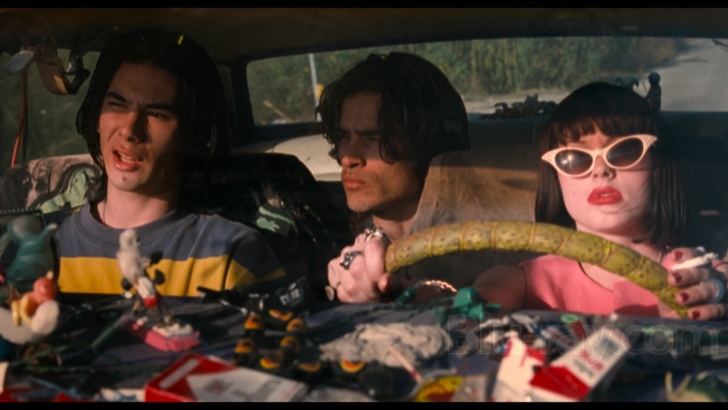
The Doom Generation's portrayal of disaffected and alienated teens, Araki's scatological jokes, and the movie's frequent mix of sex and hyper-violence divided critics upon its release in 1995. The picture did receive its share of glowing reviews, though. For example, the Miami Herald's Rene Rodriguez declared it "Araki’s boldest — and best — movie yet, his most blatantly offensive, his most sexually explicit and by far his bloodiest." Likewise, Manohla Dargis of LA Weekly named it "the writer-director’s best film yet, and one of the true highs of the current [autumn '95] movie season." Barry Walters of the San Francisco Examiner thought that TDG benefited from having a higher budget (for an indie) and good actors: "[The film] represents a major artistic leap forward for writer-director Araki, whose previous work has been high on scathing social observation and clever cinematic references but low on acting ability and budget...color-drenched noir with MTV pacing, experimental camera work and a well-chosen cast that revels in the non-stop deadpan comedy and claustrophobic sexual tension." Ray Mark Rinaldi of the St. Louis Post-Dispatch "got" what Araki was trying to say: "[Araki] taps so effectively into the culture of teens with nothing to do that the subsequent action — the hyper-violence and the gore — isn’t so hard to accept." Critically, the picture arguably fared enough better overseas. The late Derek Malcolm, then the film critic for The Guardian, lauded Araki's writing: "a much smarter-looking and funnier film than Araki has so far given us....Araki’s most striking film." The Toronto Star Rob Salem described TDG as "the nastiest, funniest, lewdest, loudest teen killer roadflick of them all." The Sydney Morning Herald's Paul Byrnes wrote it "may be the first Generation X masterpiece....The Doom Generation has such a strong sense of character reality." Writing in the Australian paper The Age, prolific film writer Adrian Martin understood that Araki's picture has its roots in the American underground and is a more challenging and subversive indie than that from Araki's contemporaries: "[S]tylistically, it is a blast from the American 'underground' film scene — far more jagged, exaggerated, fragmented and outrageous than the comfortable 'independent" fare from the likes of Richard Linklater or Hal Hartley."
The Doom Generation Blu-ray Movie, Video Quality 
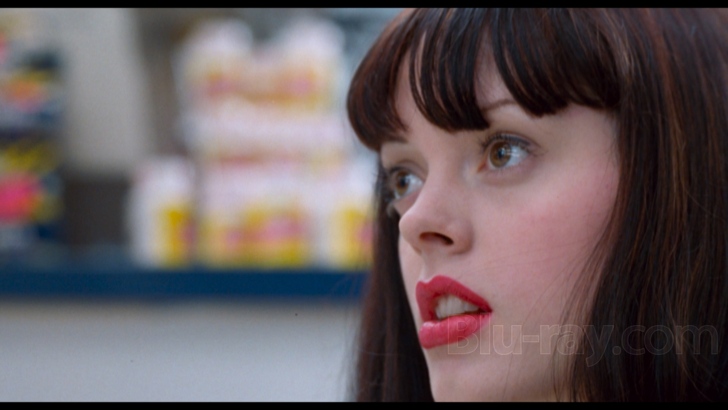
Strand Releasing gives The Doom Generation its global debut on Blu-ray with a remastered 2K transfer approved by writer/director Gregg Araki. This is taken from a 4K scan of extant film elements. This is the fully uncut version that first premiered at Sundance in 1995. There have been uncensored versions that have appeared on VHS and DVD containing much, if not all, of the footage on this Blu-ray. But the 1998 Trimark and 2007 Lionsgate DVDs are both presented in 1.33:1. Ararki laments in the "Director's Notes" on the reverse side of the front cover that the pan-and-scan transfer is "so technically inferior it makes me queasy watching it." Cinematographer Jim Fealy shot TDG in 1.85:1. (This was the first time an Araki picture was filmed on 35 mm.) Some of the international DVDs of the movie present it in 1.85:1, including the Second Sight Films disc released in 2012. Strand's press notes state: "The film has been completely retimed and reedited for today's technological standards." The colors haven't been tweaked much from DVD, though. If you notice from the handful of shots I've assembled from the Strand and Second Sight transfers, the Blu-ray has boosted the brightness by a shade or two. The banner "AMERICA: LOVE IT OR LEAVE IT" in the Quickie Mart has a darker, more natural blue in SD than on the BD, I'd argue. Also, the lighting is more pronounced on the checkerboard floor when one compares the Strand with Second Sight's, which is darker. The Strand shows more picture information along the left and right edges. The Blu-ray shows some dirt in the first reel and occasional white specks, which are very small. The Boston Globe's Jay Carr characterized the picture as "photographed at night in neon light, or through a series of popsicle-colored filters." One comes away with that aesthetic impression especially when viewing the 1080p presentation. The MPEG-4 AVC-encoded BD-25 displays a mean video bitrate of 30957 kbps. My video score is 4.25/5.00.
Screenshot #s 1-15, 17, 19, 21, 23, & 25 = Strand Releasing 2023 4K-scanned Blu-ray
Screenshot #s 16, 18, 20, 22, & 24 = Second Sight Films 2012 DVD
Eight chapters accompany the 83-minute feature.
The Doom Generation Blu-ray Movie, Audio Quality 
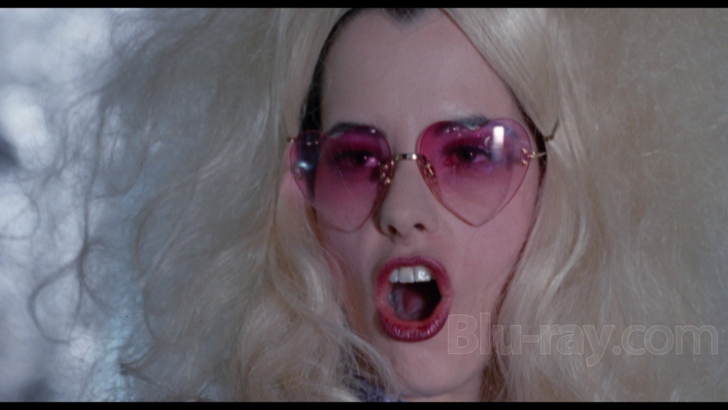
Strand has supplied a DTS-HD Master Audio 5.1 Surround remix (3679 kbps, 24-bit) as the lone film sound track. From Strand's press notes: "The sound is remastered to compliment today's new audio standards in a new 5.1 mix." Much of the sound track is situated along the front channels. Dialogue is very clear and crisp. The background surrounds are mainly used when there are songs heard and there are a lot of them. (Excerpts from twenty-six ballads in all.) Araki incorporates music from Nine Inch Nails, Belly, The Jesus & Mary Chain, Cocteau Twins, Pizzicato Five, Love & Rockets, and many other bands. Late in the film, Araki makes effective use of the SR speaker for a dialogue passage.
Strands provides optional English SDH for the feature.
The Doom Generation Blu-ray Movie, Special Features and Extras 
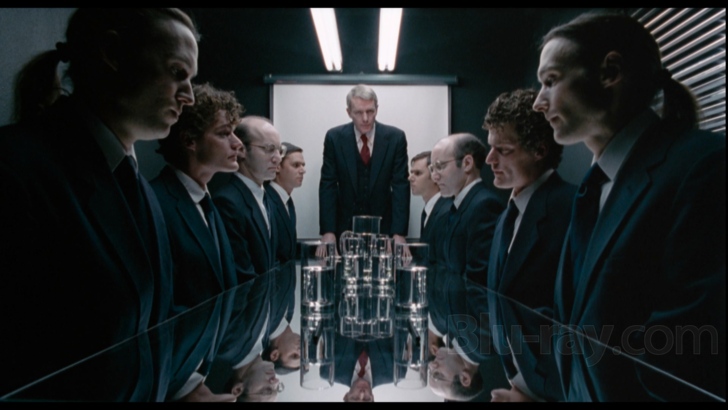
Strand's release includes an archival commentary track and ancillary extras. Missing is an exclusive 25-minute interview that Second Sight did with Araki in 2011 for the UK DVD. The writer/director discusses the origins of The Doom Generation and his Teenage Apocalypse Trilogy. He also describes working with Rose McGowan, James Duval, and Johnathon Schaech. In addition, Araki spends time explaining why he had celebrities and well-known figures in pop culture make cameos in the film.
- Audio Commentary with Director Gregg Araki and Actors Johnathon Schaech, James Duval, and Rose McGowan - this feature-length commentary was recorded for the Second Sight disc. This is a very uproarious laugh track with McGowan, Schaech, and Duval dominating air time with anecdotes and reflections of working on The Doom Generation. Araki is by far the most subdued. He imparts some valuable info about the shoot. This is a primarily scene-specific track. In English, not subtitled.
- Photo Slideshow (1080p) - a slide show comprising forty-six distinct images. The first fourty-five are snapshots taken during the making of The Doom Generation. Most images take up most of the 16x9 frame while several others fill it. They are all in color. The last still is the movie's poster.
- Doom Generation Comic Book (not time-coded) - a sideshow of storyboards with text that resemble the format and layout of a graphic novel. The illustrated piece displays some scenes that are modeled after the film.
- Original Theatrical Trailer (1:32, upscaled to 1080i) - Trimark's official trailer for The Doom Generation presented in 1.33:1 with Dolby Digital 2.0 Stereo (192 kbps).
- Remixed & Remastered Trailer (1:24, 1080p) - Strand's re-release trailer for The Doom Generation that touts the 4K restoration. It appears in 1.78:1 anamorphic widescreen with Dolby Digital 2.0 Stereo (192 kbps).
- More Films by Gregg Araki - trailers for The Living End (1:45, upscaled to 1080i), Mysterious Skin (1:45, 1080p), and Nowhere (2:07, upscaled to 1080i).
- Other Strand Trailers - additional trailers for Girl Picture, Peter von Kant, Psycho Beach Party, and Will-o'-the-Wisp.
The Doom Generation Blu-ray Movie, Overall Score and Recommendation 
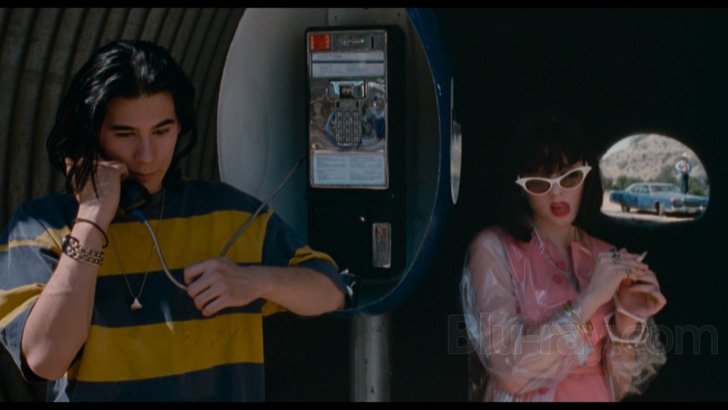
Araki's radically innovative The Doom Generation blends punk, black comedy, and horror in this acid trip of a road movie. Strand Releasing's recent 4K restoration of the picture is very good. It's noticeably brighter than Second Sight's DVD. It looks relatively clean and very sharp. I would have appreciated more grain as there is on the R2 UK DVD. I also would have liked Strand to have offered the original stereo on an alternate track. Second Sight presents it as a Dolby Digital 2.0 mix on its SD disc. The vintage commentary track has been rehashed here. (I would have loved one with just Araki.) Strand's other extras are short. The Second Sight has a very fine interview with Araki. I am highly anticipating Strand's 4K restoration of Nowhere. The indie label's edition of TDG earns a SOLID RECOMMENDATION.
Similar titles
Similar titles you might also like

Nowhere 4K
1997

Totally F***ed Up
1993

King of Chinatown
1939

Shallow Grave
1994

The Big Sleep
1978

Eating Raoul
1982

Female Trouble
1974

Relaxer
2019

Dangerous to Know
1938

Twilight
1990

A Woman Kills
La Femme Bourreau | Limited Edition
1968

The Immoral Three
1975

Kind Hearts and Coronets
1949

Triangle of Sadness 4K
2022

The Black Report
Black Statement Book
1963

Deadly Weapons
1974

The Rambling Guitarist
ギターを持った渡り鳥 / Guitar wo Motta Wataridori
1959

Polyester
1981

Double Agent 73
1974

Winter Wind
Sirokkó
1969

